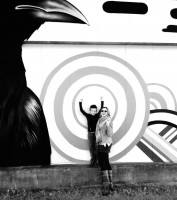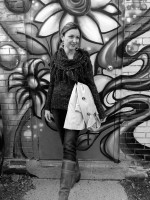Finding what makes humans more resilient
by Kathleen McCoy |

Psychology professor Rebecca Robinson listens to a presentation in the psychology class she teaches. (Philip Hall/University of Alaska Anchorage)
Are you a dandelion or an orchid?
For a very long time, psychologists considered our ability to bounce back from adversity as a measure of our own internal gumption. Survivors are tough dandelions; they thrive wherever they are.
Orchids, conversely, are beautiful but delicate. They too can be hardy and strong, but only if conditions are absolutely perfect.
Therein lies the dilemma of human resilience. If dandelions can take almost anything, but orchids require perfect conditions, is that the end of the story? You either have it or you don't?
UAA psychology professor Rebecca Robinson says not so fast. The dandelion/orchid dichotomy isn't her invention, but it underpins her belief that these two opposites make for a rather convenient societal excuse for avoidable pathologies.
If orchids can thrive in a carefully cultured environment, then the community still has responsibility to help with that climate. In other words, "We-the community, a culture, a psychologist-have a responsibility to make sure the environment nurtures all of our people, not just the hardy dandelion."
Robinson calls this a "model of resilience that is about intervention. It's about thinking about what resources we can actually work with that support people."

Rebecca Robinson and her 9-year-old son Luca near Bartlett High School. (Photo courtesy of Rebecca Robinson/University of Alaska Anchorage)
Robinson is dually trained as a clinical and a community psychologist, a 2013 graduate of UAA's doctoral program that straddles both practices. For five years, she's worked with Anchorage's emerging refugee populations, which grows by about 120 people a year. She also completed national research on Somali refugees in Minnesota and Alaska.
Despite their exposure to homeland violence and trauma, displacement and malnutrition in refugee camps and final resettlement in unfamiliar territory, Robinson's research shows that displaced Somalis can thrive. She points to specific examples in Anchorage.
"They have one or two local restaurants. Many of them work as cab drivers. And we have two halal grocery stores in town now," Robinson says. "For such a small population so new to town, that alone is a testament to their resilience."
A key component of her work is deciphering examples of resilience so that any transferable lessons might be shared or at least better understood. Her doctoral work uncovered a key source of this group's ability to regroup and thrive in the face of loss and adversity.
Somalis are often credited with being amazing business people working hard for success. What bubbled up early in Robinson's research was a kind of "existential resilience, a religious spirituality." About 98 percent of her subjects identify as Muslim, and the Islam religion appears to offer them "a sense of meaning," Robinson says.
When your story is that your whole family has died and you've lost your community, your culture, everything-many people ask the question, 'why me?' she notes.
"With this population, their conceptualization of resilience was, 'We don't ask why because we know why. Everything was written before we came here.' Asking why is actually challenging and questioning your faith. So then the question becomes, 'What's next?'"
And asking that question feeds their forward-looking nature. They move on; they are resilient.
"Islam really became this meaning-making system," she said. "Because it is such a pervasive belief system, it seems to be a culturally specific component of resilience."
Taking her findings back to her community collaborators is an important mission for Robinson. She, several students and a filmmaker are working to find funding for a 22-minute documentary that would look at three levels of resiliency in the Somali community, from the individual to the family and community, to this existential spiritual component.

Rebecca Robinson, UAA psychology professor in Halifax, Nova Scotia in May of 2014. Halifax is home to the International Resilience Project where Robinson has studied and trained. (Photo courtesy of Rebecca Robinson/University of Alaska Anchorage)
Anchorage is ripe for this work. Currently Robinson is developing a needs assessment for the entire refugee community. For almost a decade, our town has been resettling about 120 refugees every year. Couple that with a thriving and diverse immigrant population, and our city and state have a growing international flavor.
Robinson sees the town at a crossroads. "Are we going to embrace this and start to realize that immigrants and refugees are not other from us, that they are us? This is truly our population."
Acculturation is often thought of as whether a refugee or immigrant successfully adapts, learns the language, becomes economically self-sufficient, Robinson says.
"Very infrequently do you hear people talking about 'How are we adapting? How are we supporting? How are we changing?'" she says. "It's really a two-way street."
 "Finding what makes humans more resilient" is licensed under a Creative Commons Attribution-NonCommercial 4.0 International License.
"Finding what makes humans more resilient" is licensed under a Creative Commons Attribution-NonCommercial 4.0 International License.














